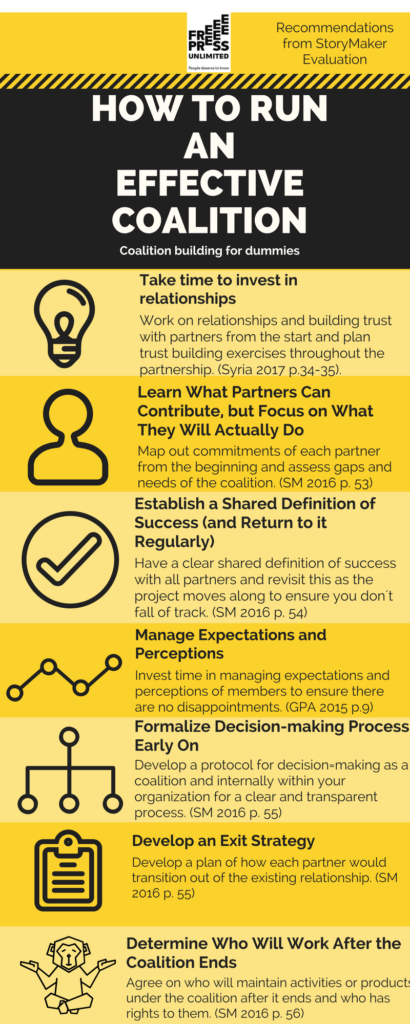Each advocacy strategy and set of inputs and activities is unique and there is no straightforward path to successful advocacy outcomes. This page provides a set of helpful resources and tools that can guide you in developing an advocacy strategy. Free Press Unlimited’s programme staff, knowledge & quality, policy & advocacy and communications teams have co-developed, assisted and supported both the advocacy activities of Free Press Unlimited and its partners throughout the years.
Online resources (updated May 2022)
In May 2022, Article19 has launched their advocacy guide Communications of the UN Special Procedures: An advocacy guide for civil society organisations. The guidelines offer a step-by-step approach how to ‘engage with the Special Procedures to help prevent and cease violations, conduct investigations, bring perpetrators to justice, and provide remedies to victims or their families’. Article19 has specifically ensured to make the guidelines ‘tailored to journalists, human rights defenders, and freedom of expression organisations’. The guidelines are available in Arabic, English, French and Spanish.
The UPR-Info Tutorials are three tools that prepare for participation in the Universal Periodic Review Mechanism and focus on the UPR Process, states and civil society (stakeholders).
Free online course on Civil Society and African Media Policy in the Digital Age. Created by Witwatersrand University in South Africa and led by a team of experts knowledgeable of various contexts in Africa and media law, this course includes sessions on civil society action for media freedom. Check out the Edx website for course updates.
Advocacy Assembly offers multiple 20-90 minute courses on topics such as building effective coalitions, podcasting for advocacy purposes and access to information in the MENA region:
Mission Possible: Gender and Media Advocacy Training Toolkit was developed following GMMP 2005 as a tool to build civil society capacity to lobby for gender-fair, gender-balanced media.
IFEX has developed this 6 steps to creating effective free expression campaigns, which helps you to choose an issue, plan and fund a campaign around it and execute it.
Advocacy Strategy Development

The advocacy & policy change composite logic model has been developed by Julia Coffman in 2007. It offers a clear overview, or menu, of all the elements that need to be considered when developing an advocacy strategy and theory of change.
Using a theory of change (ToC) has become common good in development and human rights work planning and evaluation. There are many resources out there that can be consulted. This brief (Rogers, P. (2014)) explains the main elements of what constitutes a ToC and combines this with a number of examples.
(the next three resources have been developed by Pathfinder International)
Setting Advocacy Priorities: will help you take the first step in developing an advocacy initiative selecting an issue for advocacy)
Assessing the Political Environment for Advocacy will help you understand the environment you are working in and the key factors you need to consider as you develop your initiative)
Mapping an Advocacy Strategy (this tool will help you plan a concrete strategy for achieving your goal, including determining your specific activities)
This advocacy strategy worksheet is based on the Pathfinder International documents and can be used as a planning document.
Additional analytical tools for stakeholder and problem analysis and coalitions
How to conduct a stakeholder power analysis (Aziz)
Development tools (problem tree process; force‐field analysis; power mapping process, policy timelines / event planning; paths of influence; stakeholder analysis)
Organising Multi-Stakeholder Processes (see p.103, lesson 11)
What makes an effective coalition?

Advocacy Evaluation
“Evaluation methods define how data are collected. They are systematic approaches for gathering qualitative or quantitative data that can be used to determine whether a strategy is making progress or achieving its intended results”
Julia Coffman
Free Press Unlimited has been using the Outcome Harvesting methodology to monitor and evaluate a considerable part of our work. The methodology focuses on a change in the behaviour of persons and between organisations or between communities; changes in regulations, formal laws or cultural norms.
Advocacy Evaluation Mini-Toolkit (LFA Group) is a first step introduction to advocacy evaluation which will help you to define what needs to be considered for a proper evaluation.
A User’s Guide to Advocacy Evaluation Planning (Harvard Family Research Project). A tool that generates the core elements of an advocacy evaluation plan, including which outcomes will be measured and how. Based on the advocacy & policy change composite logic model (see above)
Evaluating advocacy: an exploration of evidence and tools to understand what works and why. This working paper by 3ie ‘aims to examine and discuss challenges related to evaluating advocacy initiatives, identify factors associated with successful advocacy interventions, and provide additional methods and tools to use in evaluating them.‘ These additional methods and tools include outcome harvesting, process tracing, contribution analysis (see also below), respectively after-action review, most significant change (which Free Press Unlimited has used in the past) and the policymaker rating tool (also discussed in the next document).
Unique Methods in Advocacy Evaluation (Coffman and Reed). This brief gives a summary of four methods (bellwether methodology; policymaker ratings; intense period debriefs; and, system mapping) that were developed specifically for advocacy activities and lists a number of more common advocacy evaluation methods.
Contribution Analysis in Policy Work. Assessing Advocacy’s Influence (Kane, Levine, Orians, Reinelt). This brief explains what contribution analysis is (a theory-based approach to causal analysis) and answers a number of questions which could and should be considered before applying the approach and how to execute the steps.
